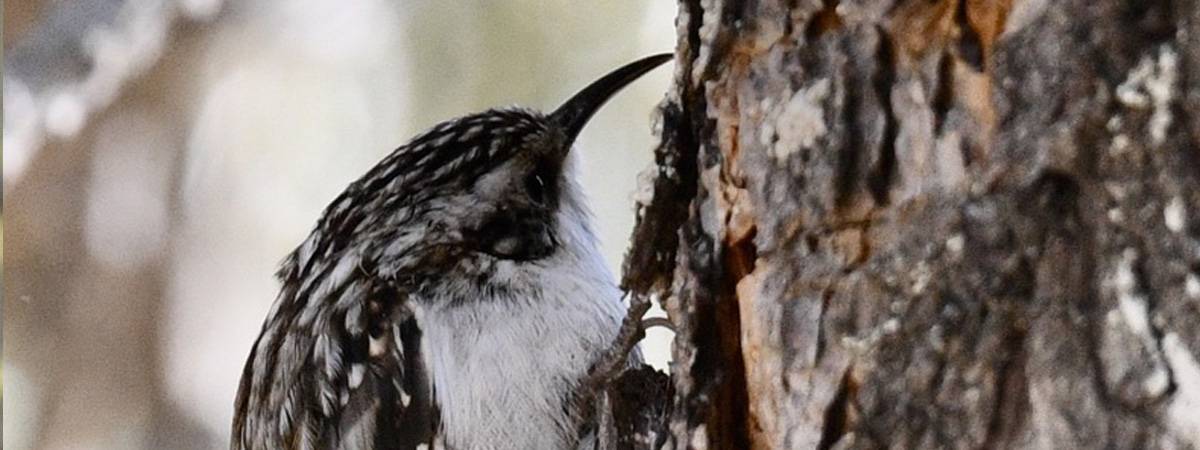Brown Creeper
(Certhia americana)
By Sevilla Rhoads
Thank you to Chuck Gates for his time reviewing our bird blog posts for accuracy.
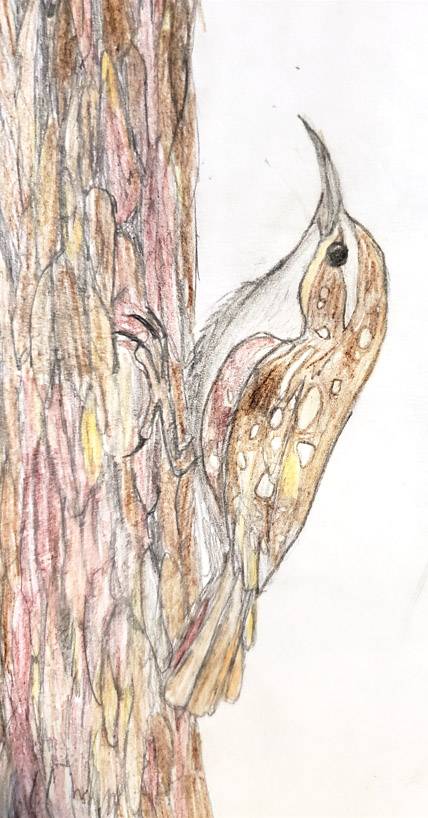
Artwork by Kenyan, Bend/La Pine Fifth Grader
One reason to pause and notice birds, even if you are not a birder, is to deepen your experience. As you watch and learn about a bird, another world paralleling your own is revealed. We become aware of other lives playing out alongside ours, full of tender and troubled relationships, awe-inspiring survival tales, tragedies, triumphs, mysteries, and even life lessons and wisdom. Discovering these stories can wake our child-like curiosity and excitement. Another layer of life opens to us and enriches the moment.
It is especially thrilling to discover a secret life hidden in plain sight. Like when reading fairy tales, our imaginations are tickled by the idea of little beings existing outside the awareness of all but the keenest, most patient seekers. Sunriver has its very own such forest creatures. The Brown Creeper literally creeps around Sunriver, evading detection right before our eyes. Invisible like a shape-shifter, if a Creeper moves, you rub your eyes in disbelief because a piece of bark seems to have come to life.
The Creeper is a common Sunriver bird, yet few have seen or know it. A mosaic of wood colors, its back perfectly matches the tree trunks where it feeds and nests. The Creeper prefers the interiors of mature tree stands, where it uses a relatively long curved bill to pry out insects from bark cracks. Downward curved beaks are called ‘decurved.’ Having such a long and bent bill does make bath time rather challenging trying to reach all your feathers for preening. Can you imagine trying to wash your neck if you had to use a long curved, and sharp nose? Observing a Creeper preening demonstrates how well they can balance on their stiff tails while they engage in pretzel-yoga cleaning poses.
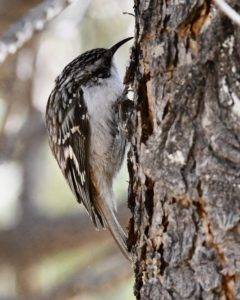
Mostly dining on insects, Creepers have a distinctive SOP forage procedure where they start near the base of a tree then circle up and around the trunk, climbing and poking about in the crevices. When they get near the top, they usually fly down, like a fluttering leaf, to the bottom of another suitable nearby tree and start again. Not surprisingly, a flock of Creepers is known as a Spiral.
Nuthatches move down trees as they feed, so the traffic flow on Sunriver’s Ponderosas is similar to our roads with two directions. We wonder if a nuthatch and Creeper have ever bumped into each other!
Another difference between Creepers and Nuthatches is the Creeper’s need for more mature groups of trees. The Forest Service and other similar organizations consider Brown Creepers to be an ‘indicator species’ because their population numbers help determine the health of the forest. Creepers have evolved to eat the insects in deeper cracks which are most visible and accessible to creatures moving upwards. Nuthatches glean the insects closer to the surface which are more accessible and visible from the birds’ downward direction. Woodpeckers peck holes so they can reach the bugs beneath the bark surface. So our native trees have specialist insect eaters for each layer of their bark!
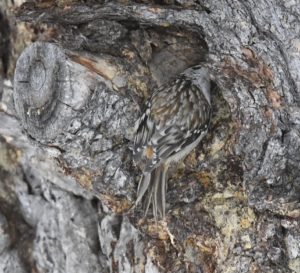
Often Creepers make tiny high-pitched squeaky sounds as they hunt. Usually, these sounds are how birders find Creepers. At any time of year in Sunriver, away from the noise of cars and such, stand as quietly as you can in a wooded area and listen. First, you will probably hear our Mountain Chickadees making various small sounds, but keep listening as the Creeper peep is a whisper in comparison. In the winter, such listening might lead you to find a flock of Golden-crowned Kinglets who also emit tiny pips, but normally the littlest chirps lead you to Creepers.
We often wonder why birds, like Creepers, Kinglets, and Chickadees, chat to each other while feeding. Surely being quiet is a better survival trait? Creepers have evolved near-perfect camouflage yet give away their position to patient listeners by constantly talking. Ornithologists studying these ‘contact’ or ‘close’ calls are not sure exactly why certain species babble at each other. Some think it is a way birds stay in touch about their position because a properly spaced flock provides some predator protection.
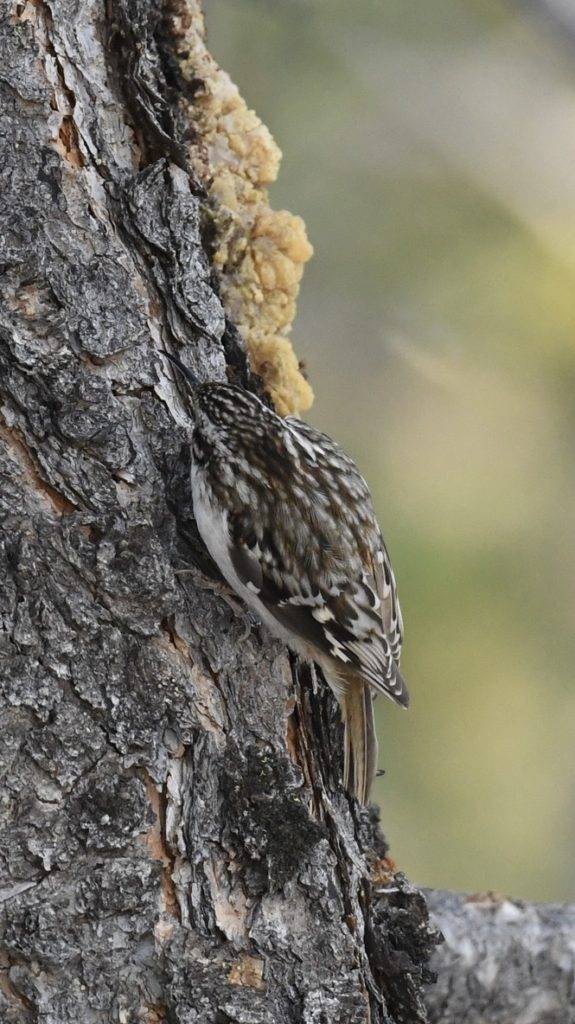
Creepers usually build nests under loose strips of bark on larger trees. They use various materials like moss and feathers to create a hammock-shaped pouch. The most surprising nest material is lots of spider cocoons. Why would birds stuff their homes with spider egg cases which then hatch into hundreds of baby spiders? There are various theories, but no one is entirely sure. Some think the egg cases provide a natural glue to help stick the nest together. Others believe the baby spiders are an excellent food source for the tiny newly hatched chicks.
Spider eggs are a smart snack option because the baby spiders provide a fresh and plentiful buffet when they hatch in the nest. Plus, they are a healthy choice because spiders are not only packed with protein but also contain a high dose of an amino acid called taurine. Scientists found that developing chicks fed taurine had improved eyesight and intelligence and perhaps were even less anxious and more courageous. https://www.sciencedaily.com/releases/2007/08/070824220328.htm. That is quite the kid multi-vitamin!
Another popular but debated theory is that parent Creepers fill the nest with spider eggs to protect their chicks from troublesome and sometimes deadly mites. In one lab study, the newly hatched spiders ate the nest mites. Whatever the reason, Creepers and Wrens collect many different kinds of spider eggs for their nests, with studies finding up to fifty different spider species in one nest!
Oregon has over five hundred spider species, and, at least according to the state’s Department of Agriculture, our local spiders have not caused any significant medical issues. https://www.oregon.gov/oda/shared/Documents/Publications/IPPM/OregonSpidersFactAndFiction.pdf. So, next time we encounter a spider in our house, we’ll put it outside for the Creepers and Wrens. According to All About Birds, a single spider is enough energy for a Creeper to climb about two hundred feet.
Nature can be a form of art gallery experience where we walk through a show of infinite creative design. Finding a Creeper to watch is like encountering a collage that took the artist over a thousand years of blending complementary tones into an almost perfect Ponderosa-resonate pattern. Camouflage can be an art form – several members of The Blue Rider (Der Blaue Reiter), a German expressionist art group, like Franz Marc and Paul Klee, used their artist sensibilities to create Kandinsky-inspired camouflage when drafted into the First World War. Perhaps due to the piece’s history feeling more relevant with the war in Ukraine, Franz Marc’s The Foxes just sold for over fifty-five million dollars. Luckily for us, seeing a Brown Creeper in Sunriver’s ‘nature gallery’ is free so long as we preserve our mature tree stands.
While the Brown Creeper only lives in North America, Europe has an almost identical treecreeper species. It is entirely possible that Franz Marc, who drew inspiration from forests and birds, looked up from painting aircraft camouflage to admire and draw joy from a Creeper’s design. Sadly, Franz was killed in battle just before his draft-release papers reached him. To see one of his last bird paintings, try https://www.wikidata.org/wiki/Q46223210
For some incredible photos of bird camouflage, see https://www.audubon.org/news/these-amazing-images-show-how-good-bird-camouflage-can-be
To learn more about Brown Creepers see https://www.allaboutbirds.org/guide/Brown_Creeper
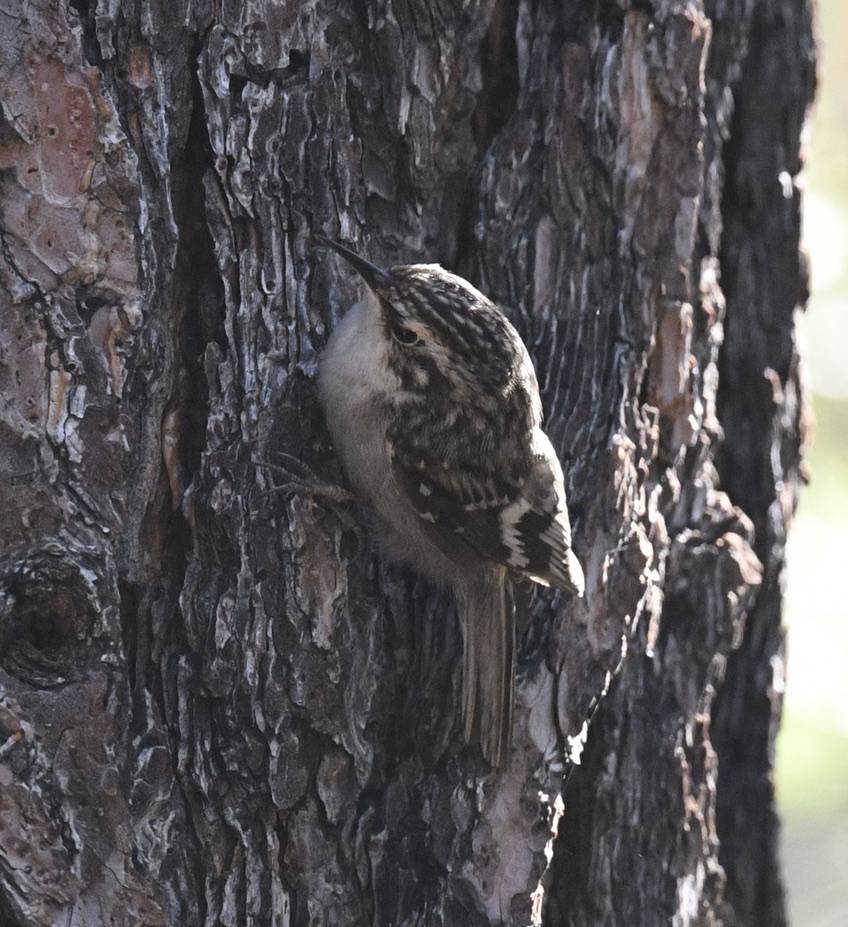
Identification Tips
The Brown Creeper is a small forest bird weighing less than .3 ounces. Five inches or less in length, Creepers forage up tree trunks often emitting high-pitched peeps. They have a dark gray or black thin bill which curves downward and is relatively long compared to the size of their heads. Their chin, chest and belly are mostly white or appearing dusky gray, whereas their backs are a bark pattern of flecked whites, browns and grays with some russet tones. Sometimes an uneven white bar shows about half way down the top of the wings. You can often see a white eyebrow over their dark, but white rimmed eyes. A Creeper’s tail is mostly brown and about the length of the full head. Like woodpeckers, Creepers use their stiff tails as support by pressing the tip into the tree.

